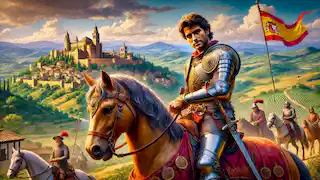The Birth of a Legend
In the year 1043, amidst the rolling hills and fertile plains of Castile, a child was born who would grow to become one of Spain's greatest heroes: Rodrigo Díaz de Vivar, later known as El Cid. His birthplace, the small village of Vivar near Burgos, was humble, yet his lineage was noble. Rodrigo came from a family of minor nobility, deeply rooted in the traditions of chivalry and service to the crown.
From a young age, Rodrigo exhibited an extraordinary aptitude for the arts of war and governance. His father, Diego Laínez, ensured he received the best education available, training him in swordsmanship, horseback riding, and the principles of leadership. These formative years shaped Rodrigo into a formidable knight, instilling in him a sense of duty, honor, and loyalty.
Rise to Prominence
Rodrigo's skills did not go unnoticed. He soon caught the eye of Prince Sancho, the eldest son of King Ferdinand I of León and Castile. As a squire in Sancho's court, Rodrigo proved his mettle in numerous skirmishes against both Moorish and Christian rivals. His courage and tactical acumen earned him the respect of his peers and the affection of the people.
In 1065, King Ferdinand I passed away, leaving his kingdom divided among his sons. Sancho inherited Castile, Alfonso received León, and García was given Galicia. This division, however, sowed the seeds of discord, as Sancho sought to reunite the kingdom under his rule. Rodrigo, now a knight, became Sancho's most trusted lieutenant, leading his forces with unmatched prowess.
The Struggle for Power
The fraternal conflict reached its peak in 1072. Sancho, with Rodrigo by his side, launched a series of campaigns to reclaim his brothers' territories. Rodrigo's leadership was instrumental in these victories, culminating in the Siege of Zamora. However, this triumph was short-lived. In a shocking turn of events, Sancho was assassinated under mysterious circumstances, leaving Rodrigo and Castile in turmoil.
Sancho's death led to a precarious situation. Alfonso, who was in exile in Toledo, returned to claim the throne of Castile. Despite suspicions surrounding his involvement in Sancho's assassination, Alfonso denied any wrongdoing. Rodrigo, ever the loyal knight, demanded that Alfonso swear an oath of innocence on sacred relics. Alfonso's compliance did little to quell the suspicions, and tension lingered between the new king and Rodrigo.
Exile and Reinvention
The strained relationship between Rodrigo and King Alfonso soon led to a dramatic fallout. In 1081, after a series of disputes, Alfonso accused Rodrigo of insubordination and exiled him from the court. Stripped of his titles and lands, Rodrigo was forced into a life of wandering.
However, Rodrigo's exile did not diminish his reputation. Seeking to sustain himself and his followers, he offered his services to various Muslim and Christian lords. His journey took him to the taifa kingdoms of Al-Andalus, where he entered the service of al-Mu'tamin, the ruler of Zaragoza. Rodrigo's unmatched military skills brought victory to Zaragoza in numerous conflicts, earning him the title "El Cid," derived from the Arabic "Al-Sayyid," meaning "The Lord."
The Journey to Valencia
In 1087, political circumstances in Castile necessitated Rodrigo's return. King Alfonso, facing threats from both internal rebellions and external invaders, recognized the need for El Cid's expertise. Rodrigo returned to Castile, not as a subordinate, but as an independent leader with his own loyal army.
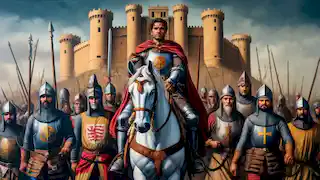
El Cid's most renowned campaign began in 1093 when he set his sights on Valencia, a wealthy and strategically vital city under Moorish control. Situated on the Mediterranean coast, Valencia was a prize that both Christian and Muslim rulers coveted. Rodrigo saw its conquest as a personal challenge and a means to secure his legacy.
The Siege of Valencia
The siege of Valencia was a testament to El Cid's military genius. Understanding the city's strengths and weaknesses, he employed a combination of relentless assaults, strategic alliances, and psychological warfare to weaken its defenders. He cut off supply lines, undermined morale, and won the support of disaffected factions within the city.
The siege lasted for many months, testing the resolve of both the attackers and the defenders. Despite the hardships, El Cid's leadership kept his forces motivated. His charisma and tactical brilliance inspired loyalty and fearlessness among his men. In the spring of 1094, Valencia finally capitulated, and El Cid entered the city as its conqueror.
Rule of Valencia
El Cid's rule over Valencia was marked by wisdom and pragmatism. Unlike many conquerors, he adopted a policy of tolerance, allowing both Christians and Muslims to coexist peacefully. He respected local customs and laws, integrating his governance with the city's established traditions. This approach won him the loyalty and respect of Valencia's diverse populace.
Under El Cid's leadership, Valencia flourished. He strengthened the city's defenses, revitalized its economy, and promoted cultural exchanges. His court became a center of learning and diplomacy, attracting scholars, poets, and envoys from across the Mediterranean world. El Cid's ability to balance firmness with fairness ensured stability and prosperity for Valencia.
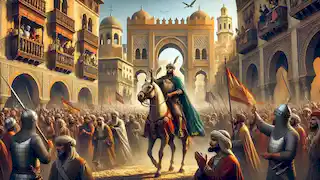
The Almoravid Threat
El Cid's success did not go unnoticed by the powerful Almoravid dynasty in North Africa. Alarmed by his growing influence, they launched a massive invasion in 1097, determined to reclaim Valencia and crush El Cid's power. The stage was set for a climactic confrontation between El Cid's forces and the Almoravid invaders.
The ensuing battle was one of epic proportions. Despite being heavily outnumbered, El Cid's strategic brilliance and the unwavering loyalty of his troops turned the tide in their favor. He used the terrain to his advantage, launching surprise attacks and exploiting the enemy's weaknesses. El Cid himself led the charge, his presence on the battlefield inspiring his men to fight with unmatched ferocity.
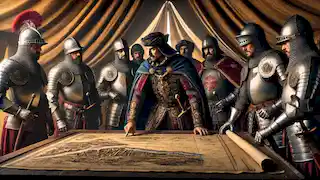
Victory and Loss
The battle against the Almoravids was fiercely contested. El Cid's forces, though outnumbered, fought with unparalleled determination. The clash of swords, the cries of warriors, and the thunder of hooves filled the air as the two armies clashed. El Cid's tactical brilliance and his men's unyielding courage eventually prevailed, securing a decisive victory.
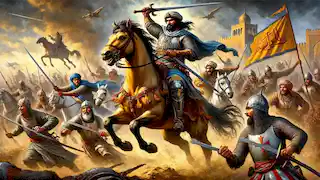
However, the victory came at a great cost. Many of El Cid's loyal followers fell in battle, and he himself was gravely wounded. Despite his injuries, El Cid continued to lead his men with unwavering resolve. His indomitable spirit inspired those around him, and Valencia remained secure under his rule.
The Final Days
El Cid's triumph over the Almoravids marked the pinnacle of his career. Yet, his health began to deteriorate. The wounds he sustained in battle took their toll, and he grew weaker with each passing day. Despite his declining health, El Cid continued to govern Valencia with wisdom and justice.
In the year 1099, El Cid succumbed to his injuries. His death was a profound loss for Valencia and for Spain. His wife, Jimena, assumed control of the city, continuing his legacy of fair and tolerant rule. However, without El Cid's formidable presence, Valencia's fate hung in the balance.
The Fall of Valencia
Jimena's rule over Valencia faced immense challenges. The Almoravids, undeterred by their previous defeat, renewed their efforts to reclaim the city. Despite Jimena's valiant attempts to defend Valencia, the city's defenses were gradually worn down. In 1102, the Almoravids launched a final, overwhelming assault.
The fall of Valencia was a poignant end to El Cid's legacy. Jimena and her followers were forced to flee, and the city once again came under Muslim control. However, El Cid's memory endured, his exploits immortalized in the hearts and minds of the people.

The Legend Lives On
El Cid's story did not end with his death or the fall of Valencia. His legacy lived on through the epic poem "El Cantar de Mio Cid," which recounted his life and deeds with a blend of history and legend. The poem celebrated his virtues of bravery, loyalty, and honor, cementing his status as a national hero.
Through the centuries, El Cid became a symbol of Spain's enduring spirit. His name was invoked in times of war and peace, his legend inspiring generations of warriors and leaders. El Cid's story transcended the boundaries of time and place, becoming a timeless testament to the ideals of chivalry and heroism.
El Cid in Popular Culture
In modern times, El Cid's legacy continued to captivate the imagination of people worldwide. His life and deeds were depicted in literature, art, and film, each portrayal adding new dimensions to his legend. El Cid's story resonated with audiences, embodying the timeless struggle for justice and the triumph of the human spirit.
The cinematic adaptation of his life, particularly the 1961 film "El Cid" starring Charlton Heston, brought his story to a global audience. The film's portrayal of El Cid as a noble and valiant hero captured the essence of his character, making him a cultural
icon.
The Historical Context
To fully appreciate El Cid's legacy, one must understand the historical context of his time. The Iberian Peninsula in the 11th century was a land of complex political dynamics, marked by the coexistence and conflict of Christian and Muslim kingdoms. This period, known as the Reconquista, was characterized by shifting alliances, religious fervor, and relentless warfare.
El Cid's life was deeply intertwined with these historical currents. His alliances with both Christian and Muslim rulers reflected the pragmatic realities of medieval politics. His ability to navigate these complexities and emerge as a legendary figure is a testament to his extraordinary leadership and vision.
The Lessons of El Cid
El Cid's story offers valuable lessons for contemporary audiences. His unwavering commitment to his principles, even in the face of adversity, serves as a powerful example of integrity and resilience. His ability to unite diverse peoples and promote coexistence highlights the importance of tolerance and understanding in a divided world.
El Cid's legacy reminds us that true heroism lies not in the pursuit of power, but in the pursuit of justice and the greater good. His life encourages us to strive for excellence, to stand firm in our convictions, and to lead with compassion and wisdom.
The Enduring Myth
El Cid's legend continues to inspire and captivate. His story, rooted in history yet enriched by myth, embodies the timeless ideals of chivalry and honor. As long as tales of valor and heroism are told, the name of El Cid will endure, a beacon of the enduring spirit of humanity.
